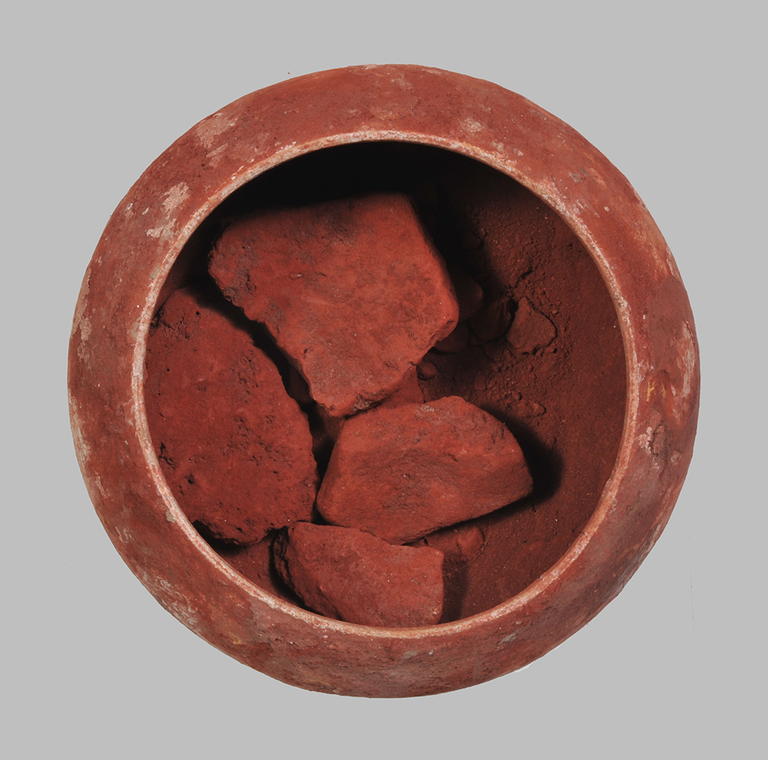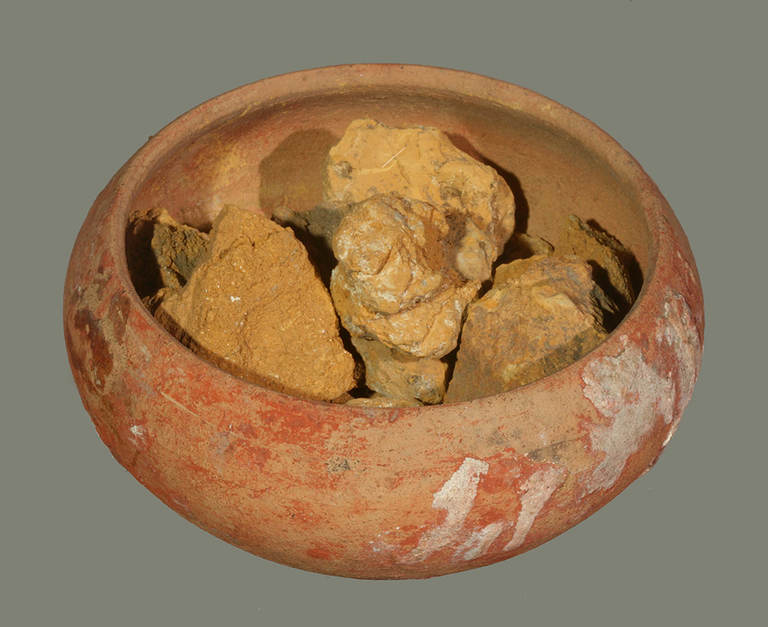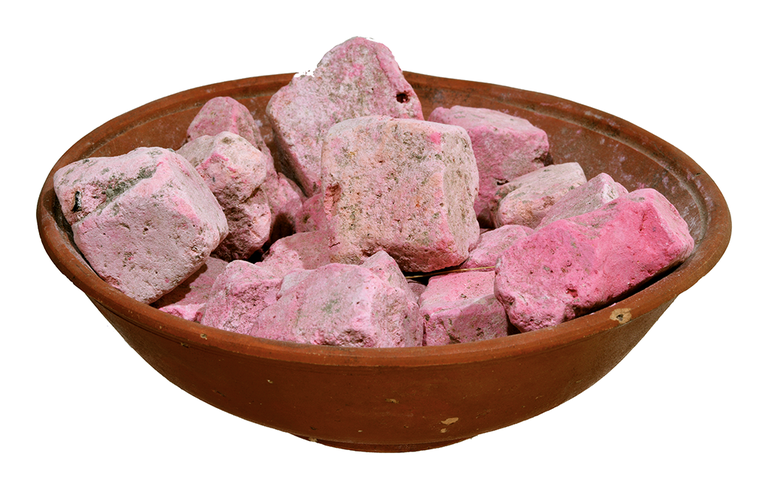
 4
4














 3
3




 2
2




One of the most remarkable findings of the research was the identification of Pompeian Gray, a previously unknown color in the Roman world. This particular shade is distinguished by the presence of barite and alunite, providing the first evidence of the use of barium sulfate in ancient Mediterranean mural painting.
The mixture of these minerals gave the pigment a grayish tone with a singular chromatic depth, possibly used to enhance realism and volume in pictorial compositions.
 2
2




The pot ref. 9521, found in the House with Workshop, keeps a small
violet block (L* = 67.17; a* = 4.00; b* = 7.48) that appears as a cohesive
mixture of dark red (ca. 46 %), white (ca. 44 %), yellow (ca. 9 %) and
rare blue grains(ca. 1 %) (Fig. 4d). Chemical composition of this mixture
is featured by predominant Fe, moderate amounts of Cu, Ca, and Si, with
lower Pb and K and traces of As (Table S1). FORS highlighted that the
predominant iron is due to the red ochre, as the reflectance curve
(Fig. S4) shows the band at ~580 nm, typical of this type of pigment.
FTIR supported FORS data, revealing the bands of red ochre at 3360,
1626, 1038, 779, 695, 574, 434 cm− 1 (Fig. 4c). Moreover, peaks of
calcite (1417, 873, 712 cm− 1) and aragonite (1447, 855 cm− 1) were also
observed (Table S1). Thus, the colour was obtained by mixing inorganic
pigments: the main component is the red ochre (rubrica), added to
carbonate-bearing substrate (creta). However, microscopic observations
and the presence of Pb, Cu and traces of As revealed a more complex
recipe, obtained by adding red lead (cerussa usta), Egyptian blue
(caeruleum, see below) and traces of orpiment (auripigmentum) as tone
correctors (Table 2).
from a complex mixture of inorganic compounds at Pompeii, since all
pigments with a violet shade so far investigated were obtained by using
the purpurissum (Augusti, 1967; Cottica and Mazzocchin, 2009; Giachi
et al., 2009; Marcaida et al., 2016). Only occasionally, the addition of
Egyptian blue was observed to obtain the desired tonality (Marcaida
et al., 2016).
The powder comes from some lumps of unused pink-purple pigment that were excavated at Pompeii. Pliny described a purple pigment ‘purpurissum’ that was made by dyeing a colourless earth substrate with shellfish purple
 2
2




The detection of Br by elemental analysis such as EELS or EDX is
complicated by the presence of Al. There are problems is using historical texts such as Pliny. What did he mean by ‘hysginum’ or ‘creta argentaria’? ‘Creta’ literally means chalk, but many white earths such as kaolinite-rich clays (or diatomite) are indistinguishable from pure white chalk to the naked eye, and so any of these could have been called “creta” by the Romans. It was also unclear what Pliny meant by dyeing “with” purple textiles.
A possible explanation for inconsistent results is inhomogeneity: if the material is an extremely diluted form of shellfish purple, it might well be inhomogeneous to such an extent that the tiny amount of sample investigated by TEM did not contain any Br, whereas that examined by DE-MS did. 44 Another explanation is that lumps may be of different origin. Some, however, e.g. 18107 and 18129, are very similar. Alternatively, an amount of debromination may have taken place with ageing, so that only the diluents (madder, indigo) remain in some samples. Alternatively, maybe some are more ‘adulterated’ by plant dye than others
 2
2





They looked to medieval sources that credited the plant, Chrozophora tinctoria, as a natural source of color that created blue and purple dyes. They were stored on cloth and dried as watercolors. When it was time to use them as paint, a piece of cloth was cut and the paint was extracted with water or another element to bind it to the page.
 1
1




"The only thing...more expensive than education is ignorance."~Ben Franklin. "We can easily forgive a child who is afraid of the dark; the real tragedy of life is when men are afraid of the light." ~ Plato
 5
5




Life's too short, eat desert first! [Source of quote unknown]
You have to be warped to weave [ditto!]
 2
2






 2
2




 2
2




Jill Dyer wrote:Hello and welcome back from the 'rabbit hole' of research! This whole subject is fascinating.
 2
2




Life's too short, eat desert first! [Source of quote unknown]
You have to be warped to weave [ditto!]
 3
3




I do Celtic, fantasy, folk and shanty singing at Renaissance faires, fantasy festivals, pirate campouts, and other events in OR and WA, USA.
RionaTheSinger on youtube
 3
3




Jill Dyer wrote:Historical material culture (the stuff people use in everyday life) is a principal interest and the how on earth did they accomplish THAT! ... (?Where did the day just go?)
--
"Whitewashed Hope: A Message from 10+ Indigenous Leaders and Organizations"
https://www.culturalsurvival.org/news/whitewashed-hope-message-10-indigenous-leaders-and-organizations
 3
3




 2
2




Finished 2 life quests (well... almost). Wondering what to do next? Zone 5b

|
cat heaven has trees that produce tuna and tiny ads
The new gardening playing cards kickstarter is now live!
https://www.kickstarter.com/projects/paulwheaton/garden-cards
|







